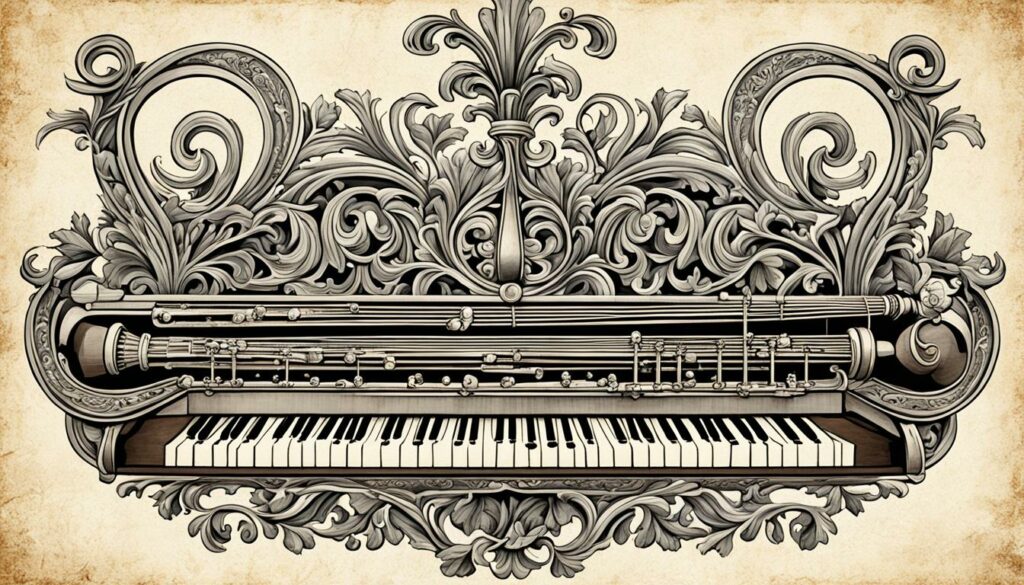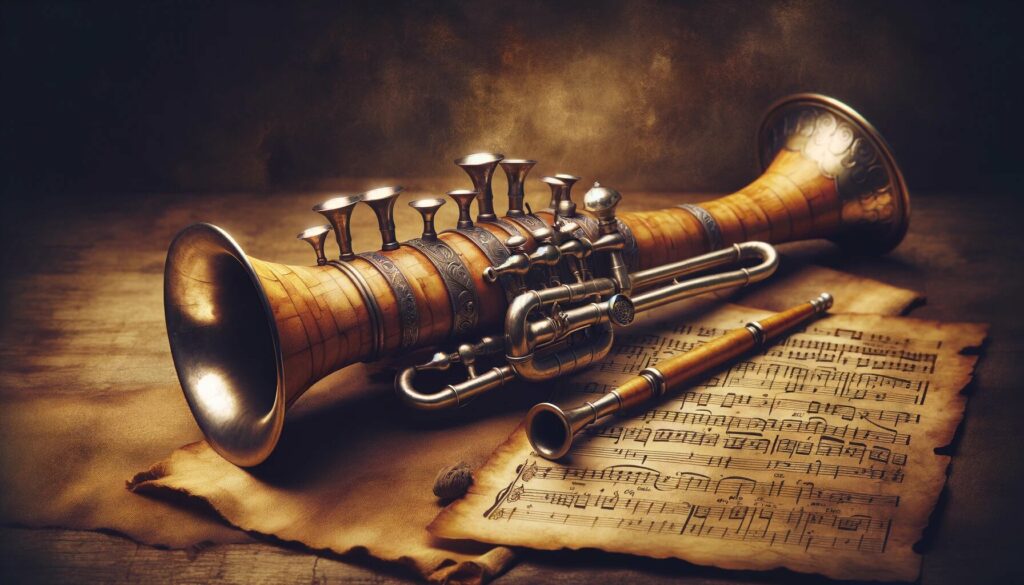Welcome to our exploration of the cornett, a cherished musical instrument that sparkled with melodic charm and boasted a unique sound during the Renaissance era. As we delve into the world of this fascinating instrument, you’ll discover why the cornett captivated the hearts of musicians and audiences alike.
The cornett, also known as the cornetto in Italian, was a prominent fixture in Renaissance and Baroque music, celebrated for its vocal-like quality. With its curved shape and slender body, the cornett resembled a woodwind and brass instrument hybrid. Made from wood and covered in leather, it featured a small cup-shaped mouthpiece, enabling skilled musicians to produce a seamless, velvety tone.
Throughout this article, we will dive deeper into Cornett’s history, playing technique, and its significance in Renaissance music. You’ll learn how the cornett differs from the trumpet, explore its various types, and discover insider tips for mastering this remarkable instrument. So join us on this musical journey as we uncover the melodic wonders of the cornett, a true Renaissance music gem.
What is a Cornett?
The cornett, also known as the cornetto or cornet, is a unique musical instrument that straddles the line between brass and woodwind. It is often featured in early music ensembles. Similar to a trumpet, it features a conical shape and a cup-shaped mouthpiece, but it is played using a technique more closely associated with woodwind instruments.
Definition and History of the Cornett
Cornett has a long and rich history dating back to the Renaissance. It was widely used in Europe during the 16th and 17th centuries and was a staple in both secular and sacred music. The instrument’s popularity peaked during the late Renaissance when it played a vital role in the vibrant musical culture of the time.
Playing Technique and Sound of the Cornett
The cornett requires a unique playing technique that involves a combination of fingerings and breath control. To produce sound, the player blows air into the cup-shaped mouthpiece and uses their fingers to cover and uncover the fingerholes along the length of the instrument. This technique allows for a wide range of expressive possibilities, enabling the cornett to mimic the human voice and produce a melodically charming sound.
Importance of the Cornett in Renaissance Music
The cornett played a crucial role in Renaissance music, serving as a versatile and expressive instrument. Its distinct sound and ability to blend seamlessly with vocal and instrumental ensembles made it a favorite choice for composers of the time. The cornett was commonly used to accompany liturgical music in churches and secular music genres such as madrigals and dance music. Its presence added a unique timbre and melodic richness to the music of the era.
How Does a Cornett Differ from a Trumpet?
Physical Characteristics and Construction Materials
The cornett and the trumpet are both renowned musical instruments, but they differ significantly in their physical characteristics and construction materials. The cornett, a brass instrument, features a curved shape with finger holes along its length. It is typically constructed using brass or wood, with a conical bore that tapers towards the bell. On the other hand, the trumpet is exclusively made of brass and has a straight cylindrical shape ending in a flared bell.
The shape and materials used in the construction of these instruments directly influence their sound production. The cornett’s curved shape and conical bore contribute to its warm and mellifluous tone, making it well-suited for melodic passages in Renaissance music. With its straight shape and cylindrical bore, the trumpet produces a brighter and more focused sound, making it ideal for fanfares and high-register melodies.
Sound Production and Timbre Variations
Sound production in the cornett and the trumpet also differs due to their distinct embouchure techniques. The cornett is a hybrid instrument that combines characteristics of both woodwind and brass instruments, making it a versatile choice in early music and baroque compositions. It requires the player to use a technique known as “voicing” to shape the sound. By changing the shape and size of the mouth cavity and utilizing precise fingerhole combinations, the cornettist can achieve a wide range of timbre variations.
While the trumpet also relies on embouchure control, its sound production is primarily based on the player’s use of airstream and lip tension. The trumpet’s cylindrical bore and narrower tubing result in a more focused sound with a sharp, piercing quality that is well-suited for projecting over large ensembles.
Roles in Different Musical Ensembles
Another notable difference between the cornett and the trumpet is their roles in different musical ensembles. In the Renaissance, the cornett was a highly esteemed instrument and held a prominent place in sacred and secular music. Its ability to blend with voices and other instruments made it an indispensable member of vocal consorts, choirs, and chamber ensembles.
The trumpet, on the other hand, was primarily used in outdoor performances, military bands, and ceremonial settings due to its powerful and projecting sound. It was often featured in fanfare groups and as a solo instrument in orchestras, showcasing its brilliance and virtuosity.
Therefore, while both the cornett and the trumpet are esteemed brass instruments, they possess distinct physical characteristics, construction materials, sound production techniques, and roles within musical ensembles. Understanding these differences is essential in appreciating each instrument’s unique qualities and historical significance.
Exploring the Different Types of Cornetts
As we continue our journey into the world of cornetts, it’s important to understand this fascinating musical instrument’s different types and variations, including the curved cornett and the cornettino, which add depth to early music performances. In this section, we will explore the distinctions between conical and straight-bore cornetts and the role of fingerholes in cornett design. We will also compare cornetts with other woodwind and brass instruments, highlighting their unique place in early music.
Conical vs. Straight Bore Cornetts
Cornetts come in two main types: conical bore and straight bore. The bore refers to the internal shape of the instrument’s tubing, which affects its sound and playability. Conical bore cornetts have a gradually expanding tubing, resulting in a mellower and warmer tone. On the other hand, straight-bore cornetts have a consistent diameter throughout the tubing, producing a brighter and more focused sound.
Both conical and straight-bore cornetts have unique qualities, and the choice between the two often depends on the player’s musical style and personal preference. The straight cornett is preferred for its clearer, more penetrating sound in baroque music.
The Role of Fingerholes in Cornett Design
Fingerholes play a crucial role in cornett design. They allow the player to control pitch and produce different notes, a feature critical when performing intricate baroque pieces. These fingerholes are strategically placed along the body of the instrument and are covered or uncovered by the player’s fingers to change the pitch. By mastering the fingerings, cornett players can achieve a wide range of musical expression and melodic possibilities.
The placement and size of fingerholes vary between different types of cornetts, contributing to each instrument’s unique characteristics. The complexity of fingerings adds to the challenge and artistry of playing the cornett.
Comparing Cornetts with Other Woodwind and Brass Instruments
While the cornett shares similarities with both woodwind and brass instruments, it possesses distinct qualities that set it apart. As a woodwind instrument, the cornett is capable of producing a rich and expressive sound reminiscent of the human voice. However, its construction utilizes materials commonly found in brass instruments, like metal and sometimes ivory.

When comparing cornetts with other woodwind and brass instruments, factors such as sound production, construction materials, and function should be considered, especially within Renaissance and Baroque music contexts. The cornett’s unique combination of woodwind and brass characteristics contributes to its appeal and versatility in Renaissance music.
| Cornett | Trumpet | Flute | |
|---|---|---|---|
| Sound Production | Rich, melodic | Bright, powerful | Pure, delicate |
| Construction Materials | Woodwind & brass | Brass | Metal, wood |
| Function | Lead, solo, ensemble | Lead, ensemble | Solo, ensemble |
The table above compares the cornett, trumpet, and flute. Each instrument offers a distinct sound profile, utilizes different construction materials, and serves various functions in musical settings, from the mute cornett’s soft tones to the cornettino’s bright sound.
By exploring the different types of cornetts and their design features and comparing them to other woodwind and brass instruments, we gain a deeper appreciation for the cornett’s unique qualities and its importance in Renaissance music.
Mastering the Cornett: Techniques and Practice Tips
Understanding the Mouthpiece and Embouchure
When it comes to mastering the cornett, understanding the mouthpiece and developing the proper embouchure is essential. The mouthpiece plays a vital role in achieving the instrument’s unique sound. It is important to pay attention to the shape and size of the mouthpiece and experiment with different placements on the lips to find the optimal position for producing a clear and resonant tone.
Developing the proper embouchure is also crucial for achieving control and accuracy while playing the cornett. This involves finding the right balance of lip tension and airflow. It is recommended to start with long tones and simple exercises to gradually build strength and control in the embouchure muscles. Regular practice and self-awareness will help players refine their technique and produce consistent and expressive sounds, whether on the treble cornett in a baroque ensemble or the zink in Renaissance music.
Playing Scales and Melodies on the Cornett
Once players have mastered the basics of the mouthpiece and embouchure, it is time to delve into playing scales and melodies on the cornett. Scales are fundamental for developing finger coordination and improving pitch accuracy. Start with the basic major and minor scales and gradually work towards more complex scales, practicing on different types of cornetts to become versatile in both baroque and early music repertoire. Remember to focus on proper finger placement and maintain a steady airflow to produce consistent notes, especially when playing the curved cornett to ensure its uniquely rich tones.
Paying attention to phrasing, dynamics, and articulation is important when playing melodies. Experiment with different ornamentations and variations to add depth and character to your playing. Listening to recordings of experienced Cornett players can inspire and guide interpretation and expression. Practice regularly and challenge yourself with a wide range of repertoire to expand your musical abilities.
Joining a Renaissance Music Ensemble as a Cornett Player
To fully immerse yourself in the rich musical tradition of the cornett, consider joining a Renaissance music ensemble or a group specializing in baroque music to explore the diverse repertoire for this wind instrument. Such ensembles provide a supportive and collaborative environment where you can interact with fellow musicians and learn from experienced performers. Participating in ensemble rehearsals and performances will allow you to refine your skills, develop a sense of ensemble playing, and explore the diverse repertoire of Renaissance music.
Joining a Renaissance music ensemble also offers opportunities for networking and professional growth. You may have the chance to collaborate with renowned musicians or perform at prestigious venues and festivals. It is important to seek out auditions or reach out to local ensembles to express your interest and showcase your skills. Remember to maintain a strong work ethic, be open to feedback, and embrace the joy of making music together with like-minded individuals.

